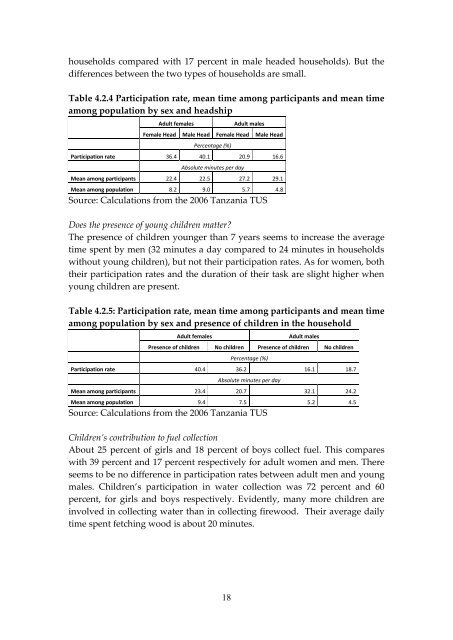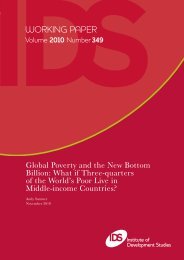Patterns of time use in Tanzania: how to make public investment in ...
Patterns of time use in Tanzania: how to make public investment in ...
Patterns of time use in Tanzania: how to make public investment in ...
Create successful ePaper yourself
Turn your PDF publications into a flip-book with our unique Google optimized e-Paper software.
ho<strong>use</strong>holds compared with 17 percent <strong>in</strong> male headed ho<strong>use</strong>holds). But the<br />
differences between the two types <strong>of</strong> ho<strong>use</strong>holds are small.<br />
Table 4.2.4 Participation rate, mean <strong>time</strong> among participants and mean <strong>time</strong><br />
among population by sex and headship<br />
Adult females Adult males<br />
Female Head Male Head Female Head Male Head<br />
Percentage (%)<br />
Participation rate 36.4 40.1 20.9 16.6<br />
Absolute m<strong>in</strong>utes per day<br />
Mean among participants 22.4 22.5 27.2 29.1<br />
Mean among population 8.2 9.0 5.7 4.8<br />
Source: Calculations from the 2006 <strong>Tanzania</strong> TUS<br />
Does the presence <strong>of</strong> young children matter?<br />
The presence <strong>of</strong> children younger than 7 years seems <strong>to</strong> <strong>in</strong>crease the average<br />
<strong>time</strong> spent by men (32 m<strong>in</strong>utes a day compared <strong>to</strong> 24 m<strong>in</strong>utes <strong>in</strong> ho<strong>use</strong>holds<br />
without young children), but not their participation rates. As for women, both<br />
their participation rates and the duration <strong>of</strong> their task are slight higher when<br />
young children are present.<br />
Table 4.2.5: Participation rate, mean <strong>time</strong> among participants and mean <strong>time</strong><br />
among population by sex and presence <strong>of</strong> children <strong>in</strong> the ho<strong>use</strong>hold<br />
Adult females Adult males<br />
Presence <strong>of</strong> children No children Presence <strong>of</strong> children No children<br />
18<br />
Percentage (%)<br />
Participation rate 40.4 36.2 16.1 18.7<br />
Absolute m<strong>in</strong>utes per day<br />
Mean among participants 23.4 20.7 32.1 24.2<br />
Mean among population 9.4 7.5 5.2 4.5<br />
Source: Calculations from the 2006 <strong>Tanzania</strong> TUS<br />
Children’s contribution <strong>to</strong> fuel collection<br />
About 25 percent <strong>of</strong> girls and 18 percent <strong>of</strong> boys collect fuel. This compares<br />
with 39 percent and 17 percent respectively for adult women and men. There<br />
seems <strong>to</strong> be no difference <strong>in</strong> participation rates between adult men and young<br />
males. Children’s participation <strong>in</strong> water collection was 72 percent and 60<br />
percent, for girls and boys respectively. Evidently, many more children are<br />
<strong>in</strong>volved <strong>in</strong> collect<strong>in</strong>g water than <strong>in</strong> collect<strong>in</strong>g firewood. Their average daily<br />
<strong>time</strong> spent fetch<strong>in</strong>g wood is about 20 m<strong>in</strong>utes.

















